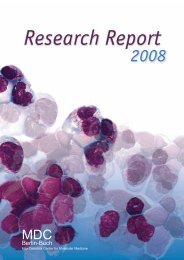You also want an ePaper? Increase the reach of your titles
YUMPU automatically turns print PDFs into web optimized ePapers that Google loves.
Phospholipids<br />
Dietrich Arndt<br />
Cytotoxic effects of antitumor<br />
agents induced at the plasma<br />
membrane level<br />
We are investigating the anticancer<br />
properties of special phospholipids.<br />
These compounds, ether lipids and<br />
alkylphospholipids (APLs), represent<br />
a new class of non-DNA-interactive<br />
compounds for cancer therapy. They<br />
act as growth factor antagonists,<br />
growth factor receptor blockers, and<br />
interfere with mitogenic signal<br />
transduction, modulate phospholipid<br />
turnover, induce differentiation and<br />
apoptosis and activate macrophages to<br />
a tumoricidal state.<br />
The aim of our research is to<br />
investigate the correlation between<br />
antineoplastic activity and the<br />
supramoleculare structure of<br />
phospholipids with antitumor<br />
properties. Thus, we are concentrating<br />
mainly on the investigation,<br />
characterization and use of liposomes<br />
prepared from phospholipids with<br />
inherent antineoplastic activity<br />
Antineoplastic activity of<br />
alkylphospholipid liposomes in<br />
human breast carcinomas<br />
We have developed sterically<br />
stabilized APL liposomes which avoid<br />
uptake by the reticuloendothelial<br />
system and can be targeted passively<br />
to tumor tissue by increased<br />
microvascular permeability in the<br />
tumor area. The bilayer of such<br />
sterically stabilized liposomes consists<br />
of hexadecylphosphocholine,<br />
cholesterol and polyethylene glycollinked<br />
phosphoethanol-amine. The<br />
reduced uptake of sterically stabilized<br />
APL liposomes correlates in vitro<br />
(J774 cells) with an increased<br />
thickness of the fixed aqueous layer<br />
around these liposomes and supports<br />
the hypothesis that the thickness of<br />
this aqueous layer is an important<br />
factor responsible for preventing<br />
opsonization, thereby resulting in<br />
reduced macrophage uptake. The<br />
pharmacokinetics of free and different<br />
liposomal APLs is in agreement with<br />
these assumptions; the serum levels of<br />
APL obtained with sterically<br />
stabilized liposomes are consistently<br />
higher than with conventional<br />
vesicles and free APL. In xenografted<br />
MaTu carcinoma, the differences in<br />
APL content between the different<br />
groups are unexpectedly low and do<br />
not reflect the high therapeutic<br />
activity of sterically stabilized APL<br />
liposomes. Detailed analysis shows<br />
that the liposomal drug displays<br />
modified pharmacokinetics which<br />
may also involve lymphatic<br />
absorption of the liposomal APL.<br />
The physical properties and<br />
pharmacological activity of liposomes<br />
made from a new, highly active<br />
alkylphospholipid (OPP) have been<br />
optimized with special reference to<br />
the composition of the vesicles. The<br />
strongest antitumor effect on<br />
xenotransplanted human breast cancer<br />
MT-3 on nude mice was obtained with<br />
sterically stabilized OPP liposomes<br />
with a low cholesterol content. The<br />
beneficial therapeutic effect of these<br />
vesicles was accompanied by better<br />
tolerance and a significant inhibition<br />
of hemolysis, compared with micellar<br />
OPP.<br />
Immunoliposomes from<br />
alkylphospholipids<br />
For active targeting, we have<br />
investigated the preparation of<br />
immunoliposomes using<br />
hexadecylphosphocholine and the<br />
monoclonal antibody fragment 4D5,<br />
specific against the p185 HER2 protein, a<br />
growth factor receptor-tyrosine kinase.<br />
Conjugation was achieved by<br />
coupling the protein via a thioether<br />
linkage to the liposomal surface. To<br />
investigate the cellular uptake and<br />
endocytosis by tumor cells, a pHsensitive<br />
fluorescence marker was<br />
encapsulated into the liposomes.<br />
Experiments in vitro demonstrated a<br />
difference in binding of liposomes,<br />
with and without antibody, to cells<br />
with different receptor expressions.<br />
For active targeting of the<br />
endothelium of the tumor<br />
neovasculature, we are investigating<br />
the preparation of immunoliposomes<br />
using APL and peptides that<br />
specifically target distinct blood<br />
vessels. Each of these peptides binds<br />
to different receptors that are<br />
selectively expressed on the<br />
vasculature of the target tissue. The<br />
tumor-binding peptides, e.g peptides<br />
containing an integrin-binding Arg-<br />
Gly-Asp motif or the Asn-Gly-Arg<br />
motif, bind to receptors that are<br />
upregulated in tumor angiogenic<br />
vasculature.<br />
Selected Publications<br />
Zeisig, R., Arndt, D., Stahn, R., and<br />
Fichtner, I. (1998) Physical properties<br />
and pharmacological activity in vitro<br />
and in vivo of optimised liposomes<br />
prepared from a new cancerostatic<br />
alkylphospholipid. Biochim. Biophys.<br />
Acta 1414, 238-248.<br />
Arndt, D., Zeisig, R., and Fichtner, I.<br />
(1998) Alkylphospholipid liposomes:<br />
preparation, properties and use in<br />
cancer research. Drugs of Today 34,<br />
83-96.<br />
Arndt, D., Zeisig, R., Fichtner, I.,<br />
Teppke, A.D., and Fahr, A. (1999)<br />
Pharmacokinetics of sterically<br />
stabilized hexadecylphosphocholine<br />
liposomes versus conventional<br />
liposomes and free<br />
hexadecylphosphocholine in tumor<br />
free and human breast carcinoma<br />
bearing mice. Breast Cancer Res.<br />
Treat. 58, 71-80.<br />
Patent Application<br />
DE 198 55 953.4. Mittel zur<br />
Tumortherapie. Erfinder: Zeisig, R.,<br />
Fichtner, I., and Arndt, D.<br />
DE 198 55 952.6 Mittel zum<br />
nichtviralen Transfer von DNS in<br />
eukaryotische Zellen. Erfinder: Zeisig,<br />
R., and Walther, W.<br />
Structure of the Group<br />
Group leader<br />
Dr. Dietrich Arndt<br />
Scientists<br />
Dr. Reiner Zeisig<br />
Technical assistants<br />
Anne-Dorothee Teppke<br />
Adnan Ibikli*<br />
* part of the period reported<br />
121

















